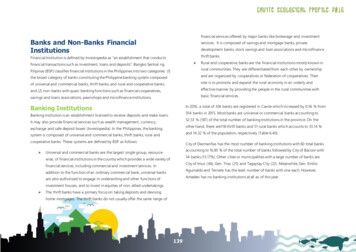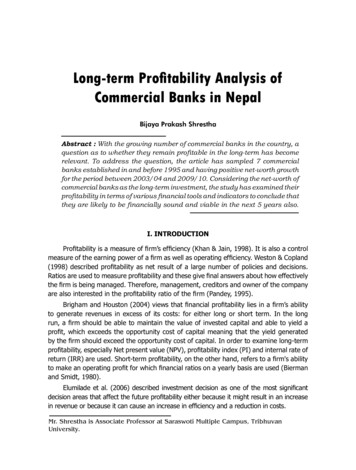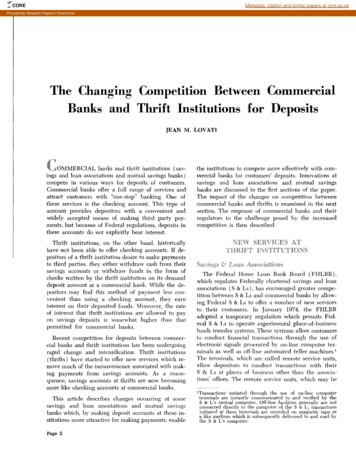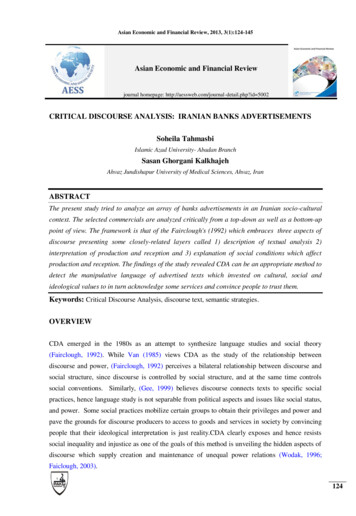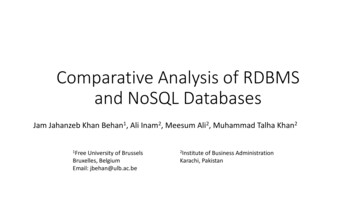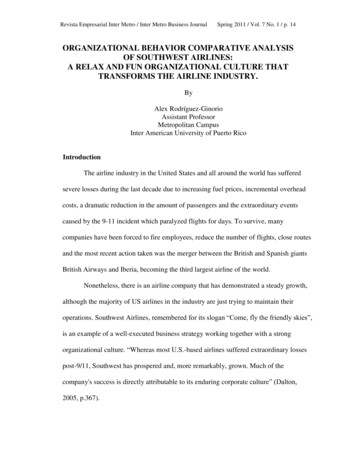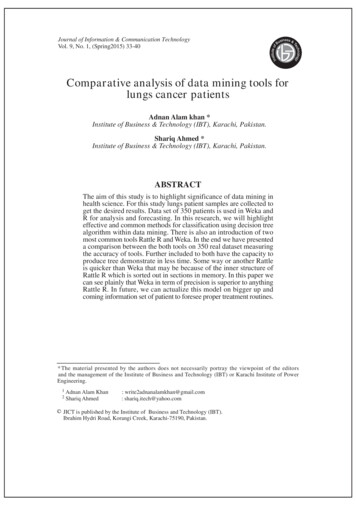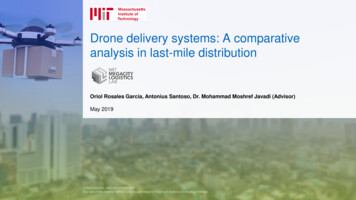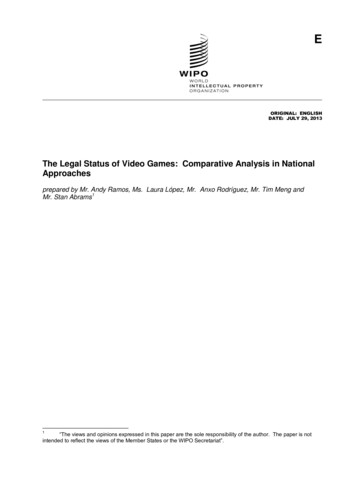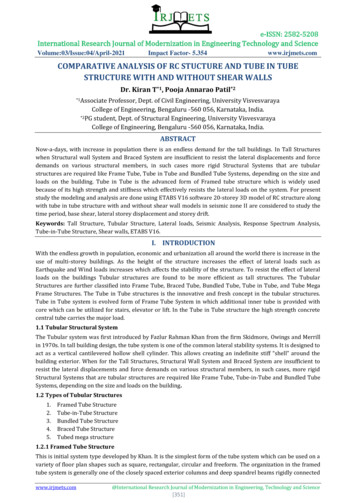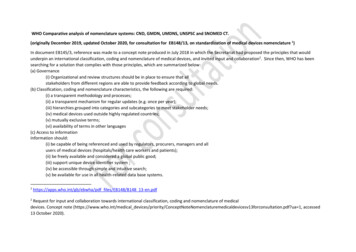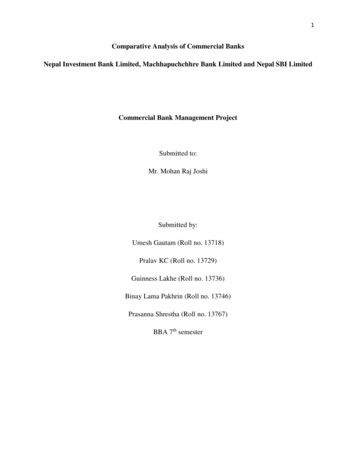
Transcription
1Comparative Analysis of Commercial BanksNepal Investment Bank Limited, Machhapuchchhre Bank Limited and Nepal SBI LimitedCommercial Bank Management ProjectSubmitted to:Mr. Mohan Raj JoshiSubmitted by:Umesh Gautam (Roll no. 13718)Pralav KC (Roll no. 13729)Guinness Lakhe (Roll no. 13736)Binay Lama Pakhrin (Roll no. 13746)Prasanna Shrestha (Roll no. 13767)BBA 7th semester
2AcknowledgementsWe would like to express our special thanks of gratitude to our college and our teacher for thecourse of Commercial Bank Management, Mr. Mohan Raj Joshi, for providing the necessaryguidelines on writing this report.We highly acknowledge with deepest sense of gratitude and indebtedness their great coordinationand support throughout the course of the work.
3Table of Contents1. Introduction .51.1. NIBL .51.2. Machhapuchchhre Bank 51.3. Nepal SBI Bank 62. Methodology 63. Analysis 73.1. Horizontal Analysis .73.1.1. Balance Sheets .73.1.2. Profit and Loss Accounts .93.2. Vertical Analysis .103.2.1. Balance Sheets .103.2.2. Profit and Loss Accounts .123.3. Ratio Analysis .133.3.1. Liquidity Trends .133.3.2. Profitability Trends .154. Findings .175. Conclusion .186. References .19List of TablesTable 1. Horizontal Analysis of Balance Sheets .7Table 2. Horizontal Analysis of Profit and Loss Accounts .9Table 3. Vertical Analysis of Balance Sheets 11Table 4. Vertical Analysis of Profit and Loss Accounts 12
4Table 5. Liquidity Trends .13Table 6. Profitability Trends .15Table 7. Summary .17
51. IntroductionThis report is a comparative study of three giant players in the commercial banking sector of Nepal– NIBL (Nepal Investment Bank Limited), Machhapuchchhre Bank Limited and NSBL (NepalSBI Bank Limited). It contains an analytical study of the three commercial banks and makes acomparative analysis of liquidity and profitability trends through ratio analysis and also verticaland horizontal study of the banks’ statements. This report gives a brief introduction of the threebanks, the methodology used in completing the study, analysis of the financial statements,CAMELS rating of the banks and findings from the comparisons. This report was completed usingthe latest information available in the websites of the respective banks.1.1. NIBL (Nepal Investment Bank Limited)Nepal Investment Bank Ltd. (NIBL), previously Nepal Indosuez Bank Ltd., was established in1986 as a joint venture between Nepalese and French partners. The French partner (holding 50%of the capital of NIBL) was Credit Agricole Indosuez, a subsidiary of one of the largest bankinggroup in the world.Later, in 2002 a group of Nepalese companies comprising of bankers, professionals, industrialistsand businessmen acquired the 50% shareholding of Credit Agricole Indosuez in Nepal IndosuezBank Ltd., and accordingly the name of the Bank also changed to Nepal Investment Bank Ltd.At present the Bank's shareholding pattern is as follows: Promoters - 70% General Public - 30%1.2. Machhapuchchhre Bank LimitedMachhapuchchhre Bank Limited registered in 1998 as the first regional commercial bank from thewestern region of Nepal. The 'A' class commercial bank started its banking operations from its
6own head office located in the foothills of Machhapuchchhre Mountain peak in the picturesquetown of Pokhara since year 2000.Now with a paid up capital of over 3.86 billion rupees, 56 Branch Offices 1 Extension Counter,and 72 ATMs spread all across the country, it is one of the full fledged national level commercialbanks operating in Nepal. It takes pride in having its own buildings for its Corporate Office inLazimpat, Head Office in Naya Bazar, Pokhara, and Branch offices in Jomsom, Baglung andDamauli.1.3. Nepal SBI Bank LimitedNepal SBI Bank Ltd. (NSBL) is a subsidiary of State Bank of India (SBI) having 55 percent ofownership. The local partner viz. Employee Provident Fund holds 15% equity and General Public30%. In terms of the Technical Services Agreement between SBI and the NSBL, the formerprovides management support to the bank through its expatriate officers including ManagingDirector who is also the CEO of the Bank. Central Management Committee (CENMAC),consisting of the Managing Director & CEO, Chief Operating Officer & Dy. CEO, Chief FinancialOfficer, Chief Risk Officer and Chief Credit Officer, exercises overall control functions with thehelp of 3 Regional Offices, and oversee the overall operations of the Bank.The SBI group consists of SBI and five associate banks. The group has an extensive network, withover 22,000 branches in India and another 198 foreign offices in 37 countries across the world.2. MethodologyThis report makes a comparative analysis of the three banks based on the following threeapproaches: Horizontal Analysis: Horizontal analysis of financial statements involves comparison of afinancial ratio, a benchmark, or a line item over a number of accounting periods. Thismethod of analysis is also known as trend analysis. Horizontal analysis allows theassessment of relative changes in different items over time. It also indicates the behaviorof revenues, expenses, and other line items of financial statements over the course of time.
7 Vertical Analysis: Vertical analysis of financial statements is a technique in which therelationship between items in the same financial statement is identified by expressing allamounts as a percentage a total amount. This method compares different items to a singleitem in the same accounting period. The financial statements prepared by using thistechnique are known as common size financial statements. Ratio Analysis: Ratio Analysis is a form of Financial Statement Analysis that is used toobtain a quick indication of a firm's financial performance in several key areas. Thecomputation of ratios facilitates the comparison of firms which differ in size. Ratios can beused to compare a firm's financial performance with industry averages. In addition, ratioscan be used in a form of trend analysis to identify areas where performance has improvedor deteriorated over time.The financial statements taken for this analysis and study are the latest as available on the websitesof the respective banks. The balance sheets and profit/loss accounts for the fiscal year 2071/72 BSor 2014/15 AD have been taken.3. Analysis3.1. Horizontal Analysis3.1.1. Balance SheetsHorizontal Analysis of Balance Sheets for the last two fiscal years 2071/72 and 2070/71NIBLCapital & LiabilitiesMachhapuchchhreRate ofSBIRate ofChangeRate of ChangeChange1. Share Capital0.3306944290.2549746290.2737388362. Reserve & -0.379939699003. Debentures and Bonds4. Borrowings
85. Deposits Liabilities0.2275470370.190496785-0.0525713766. Bills Payable-0.1935679980.2385179710.1405429337. Proposed 6-0.0294079470000000001. Cash Balance0.2258049520.1992723380.1485784092. Balance with NRB-0.2892686790.4582633330.1982645493. Balance with Banks/ Financial Instutions0.3853528920.0254098580.632560482-1005. Investments0.3951667130.294099656-0.4741287736. Loan, Advances & Bills Purchased0.2729629190.1792591660.1332098987. Fixed 94079478. Income Tax liabilities9. Other LiabilitiesTotal LiabilitiesAssets4. Money at Call and Short Notice8. Non-Banking Assets9. Other AssetsTotal AssetsTable 1. Horizontal Analysis of Balance SheetsThe above comparison between the three commercial banks shows that the share capital of NIBLhas increased by 33.07%, while that of Machhapuchchhre has increased by 25.5% and of SBI by27.37%, in comparing the year 2071/72 to the year 2070/71. Similarly, the reserve and surplus hasalso increased for all three banks but has increased by 9.6% in NIBL, 10.3% in Machhapuchchhreand by 18.5% in SBI.In the assets side, NIBL has decreased its balance with NRB by 28.9% while Machhapuchchhrehas increased it by 45.8% and SBI by 19.8%.In an overall scenario, Machhapuchchhre has had a decrease in its fixed assets by 16%. The declinein fixed assets of NIBL is negligible while SBI has increased its fixed assets by 3%. Two banks
9had an increase in their size (in terms of assets) with NIBL’s 21%, Machhapuchchhre’s 18.7%.SBI has had a decrease in its total assets size by 2%. However, in terms of total capital base andasset size, NIBL is bigger than both Machhapuchchhre (2.14 times) and SBI (more than 1.7 times).In year prior NIBL was 2.11 times larger than Machhapuchchhre and only 1.4 times larger thanSBI. This shows a fast growth rate on part of NIBL than Machhapuchhre and SBI.3.1.2. Profit and Loss AccountsHorizontal Analysis of Profit and Loss accounts for the last two fiscal years 2071/72 and 2070/71NIBLParticularsMachhapuchchhreRate ofSBIRate ofChangeRate of ChangeChange1. Interest Income-0.0051783260.096216981-0.0390583382. Interest Expenses-0.0046496020.019170791-0.20512685Net Interest Income-0.0056761060.2149876780.1733141523. Commission and 0101034740.4161875445. Exchange Profit-0.0039291430.5563133510.108179066Total Operating Income0.0062715080.2106292250.1775561846. Staff Expenses0.0967944960.2493879520.2463532667. Other Operating .015509710.2711380440.2119674419. Provision for Possible Loss1.0697328210.152603740.40587676Operating Profit-0.1195742710.3065018910.2001246910. Non-operating Income/Loss0.3167298993.8508543680.22689784311. Loss Provision Written back2.864251961-0.163482781-0.2741466864. Other Operating Income8. Exchange LossOperating Profit Before Provision for Possible
10Profit from Regular 08975363.850842738Net Profit after considering all activities0.0184076790.4067039120.18713786113. Provision for Staff bonus0.0184076810.4067039050.18713786314 Income Tax provision0.0346904960.5294460330.264968659a. Current Year0.0199213611.475316570.240846942b. Upto Previous year34.51005097186.43675580c. Deferred Tax Income/ (Expenses)-0.713087786-0.5093876171.03568411Net Profit/Loss0.0114662270.3555955310.15433868112. Profit/Loss from extra-ordinary activitiesTable 2. Horizontal Analysis of Proftit and Loss AccountsThe interest income of NIBl has had a very negligible decrease, that of SBI has decreased by 3.9%while that of Machhapuchchhre has increased by 9.6%. NIBL also has had a negligible decreasein interest expense, that of SBI has decreased by 5% and that of Machhapuchchhre has increasedby 1.9%. This shows that NIBL and SBI have managed to maintain a status quo by reducinginterest expenses in relation to interest incomes, while Machhapuchchhre has been able to achievea significant rise in interest income in comparison to interest expenses. All three banks haveincreased their provisions for possible loss, NIBL by over 106%, Machhapuchchhre by 15.2% andSBI by 40.6%.Overall scenario shows that NIBL has increased its net profit by only 1.1%, Machhapuchchhre by35.6% and SBI by 15.4%. However, in terms of volume, NIBL’s profit is greater thanMachhapuchchhre by more than 3.18 times and greater than SBI by more than 1.8 times.3.2. Vertical Analysis3.2.1. Balance Sheets
11Vertical Analysis of Balance Sheets for the last two Fiscal Years 2071/72 and 2070/71NIBLCapital & 0/71SBI2071/722070/711. Share Capital0.060814 0.0553382 0.071464 0.068172 0.065518 0.0499252. Reserve & Fund0.033171 0.0366325 0.010396 0.011282 0.029728 0.0243433. Debentures and Bonds0.014855 0.0121847000.016870.0163744. Borrowings0.002522 0.004924200005. Deposits Liabilities0.868572 0.8567716 0.9067176. Bills Payable0.000027. Proposed Dividend0.000794 0.0120301 0.000575 0.000384 0.000733 0.0030488. Income Tax liabilities09. Other Liabilities0.00000300.91180.870961 0.8922550.000276 0.000267 0.0030090000.0025600.019271 0.0221156 0.010571 0.008094 0.013181 0.011495Total LiabilitiesAssets1111110000000000000000001. Cash Balance0.025501 0.0251905 0.043012 0.042936 0.029588 0.0250032. Balance with NRB0.086183 0.1468302 0.094681 0.077729 0.0786550.063713. Balance with Banks/ FinancialInstutions0.025504 0.0222922 0.034327 0.040077 0.034067 0.0202544. Money at Call and Short Notice00.002696600005. Investments0.205688 0.1785172 0.091873 0.084992 0.157222 0.2901826. Loan, Advances & Bills Purchased0.634616 0.6036601 0.702746 0.713419 0.674443 0.5776597. Fixed Assets0.010102 0.0122811 0.015511 0.022341 0.010628 0.0099468. Non-Banking Assets9. Other AssetsTotal Assets000.0124050.0085321100000.017851 0.018506 0.015396 0.0132451111
12In liabilities the composition of each item in proportion to the total liabilities is more or less thesame. The share capital in case of SBI has increased from 49.9% to 6.5%. Other than that valuesare more or less similar.In assets side, NIBL’s balance with NRB has decreased from 14.6% to 8.6%. And SBI’sinvestments have decreased from 19% to 15.7% of the total assets. Apart from these the values arehighly similar.3.2.2. Profit and Loss AccountsVertical Analysis of Profit and Loss Accounts for the last two Fiscal Years 2071/72 and 0/712071/72207
Bank Ltd., and accordingly the name of the Bank also changed to Nepal Investment Bank Ltd. At present the Bank's shareholding pattern is as follows: Promoters - 70% General Public - 30% 1.2. Machhapuchchhre Bank Limited Machhapuchchhre Bank Limited registered in 1998 as the first regional commercial bank from the western region of Nepal. The 'A' class commercial bank started its banking
